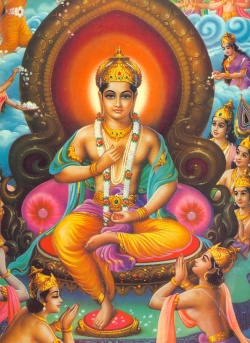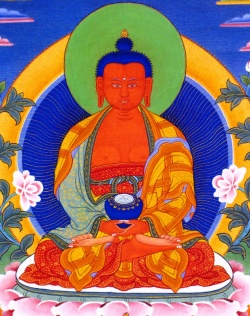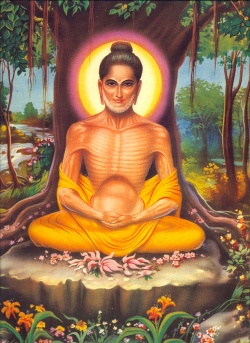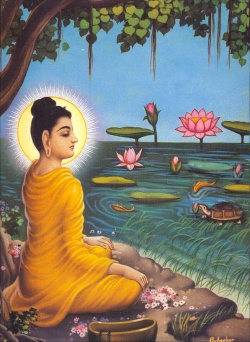The Early Life Of The Buddha By Jayaram V
Here is a brief sketch of the life of the Buddha also known as Siddhartha, Gautama and Sakyamuni, the founder of Buddhism. We have presented the life of the Buddha in four parts. This is part 1.
The Buddha was born in the year 563 B.C. in a mango grove at a place called Lumbini. Seated Buddha It is presently located in the foot hills of Nepal in the region bordering the present day India. His father Suddhodana was a Sakya king and his mother Maya also came from a princely family. Seven days after his birth his mother died, leaving him to the care of her sister and his step mother Mahajapati, who was also a wife of Suddhodana.
The young Buddha was brought up in Kapilavastha, which was the capital of Sakya kingdom. When he was born, legend records the occurrence f several miracles, confirming the arrival of a great being into the world. His father and some prominent members of his court were aware that a divine child, who was was destined to be a great person, was born amidst them. His parents gave him the name Siddhartha. They expected him to grow and become a successful and skillful king.
Siddhartha was also known in history by the name Gautama. This was in fact his family name, which he inherited from his mother's side. Princely life and the great change
We are told that knowing well what was in store for his son, his father tried his best to shield him from all possible spiritual contacts and influences by surrounding him with pomp and luxury and providing all material comforts, so that when he grew up he would become a great ruler. He built three palaces for his son with all the comforts and amenities and arranged for his training in in martial arts and education in various subjects necessary for conduct of state affairs. We are told that despite of these arrangements the young Siddhartha was still drawn occasionally into philosophical and contemplative thinking during which he would suffer from deep despair.
When he reached the age of sixteen he was married to a beautiful princess called Yashodhara. She was the daughter of a Sakya Chieftain called Suprabuddha. He had a son through her by the name Rahula. We do not know much about his family life, except that he cared for his wife and spent considerable time in her company. We do not know whether he had any liaison with some other women too. Yashodhara was probably a very dutiful wife, who might have suffered later in life when the Buddha finally left her.
During this period he went through four strange experiences which the Buddhists refer as the "Four Noble Signs". They changed his thinking completely and brought a fundamental change in his attitude towards the life he was leading till then.
The first of these signs was the sight of an old and decrepit man. This made him think about the decay inherent in all life. The second was the sight of a sick and ailing man. This made him think about the suffering inherent in existence.
The third sign was the sight of corpse lying in a bier. This made him think about the transience of human life and need for liberation from the very experience of death. The fourth was the sight of a meditating monk, who had renounced the worldly life and was leading the life of a monk. It reminded him of the possibilities of spiritual life lying beyond the boundaries of his own materialistic life.
These experiences prompted the young Siddhartha to review the life he was leading till then and change it if he could. He was overwhelmed with a sense of grief and compassion for the troubles of the mankind. He decided not to rest till he found suitable answers to the questions that were troubling him for some time. His son Rahula was just born then, as if circumstances were making it a little more difficult for him to leave his wife and worldly life behind. The life of a wandering monk
But the young Siddhartha was firm in his resolve. Ever since he saw the meditating hermit, he became eager to pursue a similar life of austerity and inner detachment. Shortly afterwards, one day, in the middle of the night, when every one was asleep, he left the palace, his family, friends and the kingdom.
But the young Siddhartha was firm in his resolve. Ever since he saw the meditating hermit, he became eager to pursue a similar life of austerity and inner detachment. Shortly afterwards, one day, in the middle of the night, when every one was asleep, he left the palace, his family, friends and the kingdom.
He felt relieved as he rode out of Kapilavasthu, in a chariot driven by his trusted charioteer named Channa, towards the deep forests that lay beyond the civilized life. After crossing a stream called Anana, he removed all his jewelry and rich clothes and gave them to Channa. He ordered him to return to the city with the chariot and all his belongings, much against the protestations and pleadings of the latter. Early struggles
After Channa's departure, he proceeded on foot to a near by mango grove called Anupia and stayed there for a week, contemplating on the possible course of action he was to take. After a few days he decided to go to Rajagriha, the capital of the famous Magadha Kingdom, ruled then by the equally famous king, Bimbisara, who was a man of noble qualities and great vision. We are told that when he was in Magadha, he was visited by king Bimbisara, who tried to persuade him unsuccessfully not to renounce his princely ways and worldly life. But Siddhartha, could not be persuaded. He remained firm in his resolve. He promised him nothing. But he gave him the assurance that when he attained enlightenment, he would first come to Magadha only to preach his gospel to the people there.
From Rajagriha, he went to meet a famous sage named Aalara Kalama who was living then in a hermitage near by. We do not know how he came to know about this sage and when he actually decided to see him. It is possible that he might have heard of the latter's spiritual eminence when he was staying in Rajagriha.
Alara Kalama accepted him as his disciple and initiated him into the secrets of ecstatic meditation. He also taught him the doctrine of Atman and the existence of Brahman. But it appears that he was not able to exert any influence on his young disciple, as probably he himself was not very conversant with the deeper aspects of the Upanishadic knowledge of Brahminism.
By all means, while staying in the hermitage, Siddhartha grew disillusioned with the teachings of his master. So after a brief stay, he decided to leave the hermitage and search for Truth on his own. Alara Kalara's teachings, especially on the nature of Atman and Brahman, convinced him that if he wanted to know the Truth he must search for it on his own. He left the hermitage and repaired to a forest near Uruvela, on the banks of river Nairanjana.
There he met five wandering monks. Like him they were also looking for liberation from the cycle of births and deaths and they believed that it could be achieved only through the strict observation of austerities and self-denial. Upon meeting him and talking to him, they decided to stay with him and pursue their path. And when the saw the sincerity behind his resolution and the manner in which started practicing austerities, they decided to accept him as their leader and master. Austerities and self-mortification
For six years, Gautama practiced several austerities and subjected himself to severe self-mortification. He led a life of hardship, complete fasting and starvation, so much so that his well groomed body was reduced to a heap of bones and skin without any flesh in between. He lost the vigor of youth and the strength to perform even ordinary tasks. Because of terrible weakness and complete exhaustion one day he fell unconscious.
When he came out of unconscious state, he felt that he was pursuing a wrong path. He became convinced that he would not get enlightenment and final liberation through a weak body that had lost its strength. He decided to leave the austere life behind and go to near by villages to beg food and strengthen his body again. A village girl by name Sujata said to have served him with milk-rice during this period, thereby ending the six-year period of his severe fasting.
The five monks who were with him till then were not happy with the change they noticed in Gautama. They wondered how Gautama who was unable to get enlightenment even after six years of severe austerities would achieve liberation if he started begging and eating ordinary food. They left him alone and went away to Isipitana, a place that was in the suburbs of ancient Varanasi. The Buddha, the Enlightened One
After they deserted him, Gautama spent some time alone in the forest contemplating the further course of action he was to take. His initial failure only strengthened his resolve to seek enlightenment. He decided not leave the place till he got the knowledge he wanted. Thus resolved, he sat under a bodhi tree and practiced deep meditation for several days. Legend has it that during this period he was subjected to many temptations by the deceitful Mara, but no amount of trickery could defeat his purpose and resolve.
Finally, after several days, one day, "when the sun was yet above the horizon", he received the answers he was searching for and received enlightenment. He entered the stage of Nirvana and became the Buddha or "the Knower".
After attaining the stage of Nirvana under the bodhi tree, the Buddha remSeated Buddhaained in the same place for a few more weeks contemplating upon the Truths he just realized and then left for the world he renounced a few years ago to preach the Truths he just realized. His early sermons
Leaving the bodhi tree, the Buddha went to Ispitana near Benares to see the five monks who deserted him few months ago. When the monks saw him approaching them they decided not to accord him any special welcome and pay him any respects. But when the Buddha came nearer them, they failed to keep up their resolve. They all stood up and bowed to him reverently. They were not aware that the Buddha had attained enlightenment. So they addressed him as 'Brother'. The Buddha requested them gently not to address him so since he had become a Buddha of clear vision. He made them sit in front of him and delivered his first sermon known as "Setting in Motion the Wheel of Law".
He taught them the middle path, the Four Noble Truths concerning the origin of suffering, the cause of suffering , the ending of suffering and the Eightfold path that would lead to the ending of suffering. After listening to the discourse, the five monks joined the Buddhist order and became his disciples. A few days later he gave them his second sermon on anatta (anatma) or the non-existence of soul.
A day after the second sermon a young man named yasa and fifty four of his companions joined the order and received initiation from the Buddha. The Buddha sent them in different directions to preach and reveal the new doctrine to other people. Conversions and expansion of the Order
He then proceeded to Uravela, where he converted some more people including a few Brahmins. Uravela Kassapa, who later became one of his prominent disciples was among them. He taught them his third sermon on the truth concerning fire of lust, the fire of resentment and the fire of enchantment.
From Uravela, he went to Rajagriha to keep his earlier promise. There king Bimbisara met him and paid him great respects. He and members of his court were converted to the new faith. He also built a monastery for the Buddha and his followers in a near by bamboo grove and requested the latter to stay there for sometime. During this period he converted two more Brahmin ascetics, Sariputta and Mogallana. Both became arhats in short time. Journey to Kapilavasthu
A few months later, the Buddha went to Kapilavasthu at the request of his father Suddhodana. He stayed in Nirgodha grove near the city and received his father and other members of the royal family. We are told that the Buddha performed a miracle infront of them to show them that he had become the Buddha and to prevent them from treating him like one of their family members. When he was at Kapilavasthu, he converted his father to Buddhism. He also saw his wife and son, who were also converted to the new faith. On his way back to Rajagriha he also converted several Sakya princes to his teachings and admitted them into his Order. Chief among them were his cousins Ananda who later became his chief attendant and Devadatta who became his arch enemy. Donations from the wealthy
By this time the Buddha's name and fame spread to various parts of the Gangetic plain. Many people began joining his Order and following him wherever he went. Many wealthy merchants impressed by his radical teaching supported his Order with their generous donations and gifts of monasteries. Prominent among them were Ananthapindika who donated the famous Jetavana grove with a monastery built in between and Vishaka, the wife of a wealthy merchant from Sravasthi, who donated a monastery to the Order at Pubbarama. Increasing influence
The buddha is credited with the act of settling a dispute between two warring groups, the Sakyas and the Koliyas by meeting them personally and convincing them of the utter futility of waging a war and causing enormous bloodshed simply for the sake of some trivial gains. He also met the famous bandit Angulimala alone and converted him and his followers to Dhamma. Admission of women
The Buddha was initially reluctant to admit women into the Order as he felt that their admission would greatly reduce the influence of His creed over a period of time. Thrice he refused to admit his step mother Gautami into the order, even against the personal requests and recommendations of his personal attendant Ananda.
But Ananda said to have prevailed upon his master to rescind his decision as he felt that women also qualified to attain Nirvana. The Buddha finally agreed to admit women into the Order, but he was said to be not well disposed towards this development. It is also recorded that he said to have told Ananda that because of this decision the Doctrine and Discipline would not long endure. He however subjected the women who joined the Order to the 'Eight Duties of Subordination to the Brethren. The Buddha's Daily life
After the enlightenment, the Buddha spent most part of his life wandering from place to place along with his monks and preaching Dhamma. During the rainy season, when the monsoon clouds gathered over the Indian subcontinent and rain poured down in great torrents, the Buddha and his followers spent time in monasteries, engaging in discussions, discourses and contemplation of the Noble Truths. During this period, the Order was well looked after by dedicated kings, wealthy merchants with generous donations and supply of food. When the rains ended and the monsoon clouds dispersed, the Buddha and hundreds of his followers went from village to village and town to town seeking alms and spreading the new creed. Increasing popularity of the Dhamma
Wherever they went the people of the place received the master with great reverence, considering it to be a rare chance to see him, if possible to speak to him and find answers to their questions. It is said that even the king Ajathasatru could not suppress his curiosity to see the Buddha personally when he heard about him from his physician Jivaka. Accompanied by his queen and a large retinue of his ministers and followers, he went to see Buddha who was staying in a mango grove near Rajagriha at that time. The Buddha said to have delivered a discourse 'on the fruits of asceticism' to him and converted him as a lay follower. It is however difficult to believe that he was ever really converted to the new faith, for the king continued to engage in destructive wars and large scale bloodshed. He even engaged the Sakyas in a war and greatly destroyed the might of the Sakyas completely. Opposition to the Buddha
The life of the Buddha was not entirely without opposition and controversy. His cousin Devadatta was one of his arch critics who was jealous of him and who tried his best to put the Buddha in difficulties. He developed enmity with the Exalted One because the latter refused to acknowledge him as his successor and true heir. It is said that he even contrived to kill the Buddha through a stratagem by engaging a mad elephant . But did not succeed as the Buddha confronted the elephant with his compassion and pacified it.
Legend states that the Buddha often engaged himself in religious debates with some heretical teachers to convince them of the efficacy of the Dhamma. Some among them, dissatisfied with his growing popularity and the strength of his arguments, said to have engaged one women named Cinca to make baseless allegations of an illicit relationship with him. The Buddha, when he heard this, maintained his demeanor and showed the strength of his character through silence and compassion. In the end the women was exposed and his opponents beat a retreat.
In the thirteenth year following his enlightenment the Buddha had to face insults from his own father-in-law, Suprabuddha. The reason for this enmity is not clearly known. But it appears that perhaps Suprabuddha never forgave his son-in-law for deserting his daughter and becoming a wandering monk. Final years
When the Master reached the age of seventy nine years, he said to have declared forty one conditions for the welfare of the Order, most of which dealt with the manner in which the monks were expected to conduct themselves and pursue their paths. he delivered the same message at Rajagriha and Nalanda. Then he proceeded to Vesali and stayed in a mango grove belonging to the beautiful, wealthy and legendary courtesan Amrapali. When she heard that the famous Buddha was staying in the mango grove, she met the great teacher and received religious instruction from him. He also accepted an invitation from her to visit her house and receive her hospitality. Amrapali later donated her mansion to the Order and was blessed by the Buddha.
From Vesali, the Buddha went to Beluva a small village where he spent his last Retreat. He fell sick there, but recovered soon as he realized that his time of departure was not yet come. But he was aware that final moments were approaching. At a place called Capala shrine he said to have informed Ananda of his approaching death and prepared him mentally for it. After some time he assembled the Brethren and made a public announcement of his fast approaching death saying," Behold now, O Brethren, I exhort you. All component things are subject to decay. Work our your salvation with diligence. The final passage of the Tathagatha will take place soon. At the end of three months hence the Tathagatha will die."
Thereafter he went to Pava where he stayed in a mango grove owned by a lay disciple, Cunda and accepted his invitation to visit his house and receive his hospitality. He became extremely sick after eating a meal in his house realized that his final hours had come. He requested Ananda to accompany him to Kusinara. That night on the outskirts of the town, in a Sala-grove of the Mallas, he left his earthly existence and passed into Nirvana.




